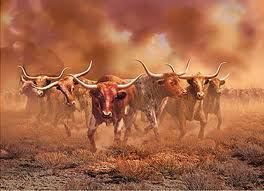Stampede! This one word, more than the warning cry that Indians or outlaws were attacking, made any cowpuncher’s blood turn cold. There was no way of foretelling it; the sudden bark of a coyote, a rumble of a summer storm, lightning, the rearing of a horse, or the scream of a panther could all start a disastrous stampede. Sometimes there was no apparent reason; it seemed as though a half-wild but dormant instinct of flight had suddenly flared up in the brain of one of the steers. As many memoirs recall, it was a terrifying experience. There would be a sudden rumble like that of a far-off cannon; then the herd would bolt. Like an army of modern steam-rollers, the steers would move across the open prairie with the speed of an express train. No one could tell what direction they would take. Sometimes they plunged off cliffs, filling whole canyons with their broken bodies, or choked a river with their thrashing. The task of the cowpunchers was to divert that terrifying, fast-moving animal mass into a gigantic circle. To do that, cowboy and pony became as one. Sometimes the stampede went on for days. No one got any sleep. There was only time for a quick drink of scalding hot coffee and then back into the saddle. “I didn’t sleep for three days,” one puncher recalled. “The heard ran for miles…” 
Follow Me
© 2025 Chris Enss | Privacy Policy | Design by Winter Street Design Group | Login

